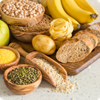
Low Carbohydrate Diet
A low-carbohydrate diet is defined as consuming less than 130g of carbs per day.
Carbohydrates provide energy by breaking down into glucose, which enters the bloodstream. Insulin, a hormone from the pancreas, lowers blood glucose by allowing cells to use glucose for energy.
Healthy sources of carbohydrate include high-fibre foods, vegetables, fruits, and legumes also supply key nutrients like calcium, iron, and B vitamins. A low-carb diet can aid weight loss and improve metabolic health.
Carbohydrates are found in two main forms: starch and sugar.

Starchy Carbohydrates
Includes potatoes, bread, rice, pasta, cous cous, plantain, fufu, breakfast cereals, oats and other grains like rye and barley

Sugary Carbohydrates
Includes honey, syrup, fruit juice, sweets, cakes and biscuits.
What can I eat?

Eggs
Eggs are very low carb and high in protein and other nutrients.

Fish
White fish - haddock, cod. Oily fish - salmon, mackerel & sardines

Fruit & vegetables
Increase your intake of vegetables and lower-sugar fruits, such as berries.

Lean meats
Skinless chicken, turkey. Pork and beef with visible fat removed.

Nuts & seeds
Provide range of vitamins, minerals and healthy fats.

Dairy
Full fat dairy - whole milk, plain yoghurts, Greek yoghurt, and cheese.
What foods should I avoid?

Sugar
Honey, table sugar. Foods containing added sugar - sweets, chocolates, ice cream, biscuits

Bread, grains and pasta
Foods made from wheat, rice and barley including bread, pasta and cereal.

Processed foods
Pies, crisps, hot dogs, sausages, fast foods, pizzas & takeaways. These are high in saturated fat, salt and sugar.

Starchy vegetables
i.e. vegetables that grow under the ground - sweet potatoes, carrots, parsnips, beetroot and potatoes.
Tips for reducing carb intake
At Home:
- Swap rice for cauliflower, broccoli couscous, quinoa, or bulgar wheat.
- Choose high-fibre carbs like wholegrains.
- Cooking from scratch helps control carb content.
- Replace spaghetti with spiralised vegetables like courgette or butternut squash noodles.
- Use lettuce leaves instead of tortilla wraps or taco shells.
- Substitute pasta sheets in lasagna with sliced aubergine.
- Use portobello mushrooms as burger buns.
- Replace potatoes with more vegetables, celeriac mash, or butternut squash wedges.
- Opt for low-carb flours like almond or coconut for baking.
- Choose coconut or almond milk over cow’s milk to reduce carbs.
- Snack on low-carb options like olives, nuts, cheese, or tomatoes.
- Replace sugary desserts with berries and cream.
Eating out:
- Skip the bun with your burger.
- Swap chips or potatoes for extra veg or a side salad.
- Opt for clear spirits with diet mixers over wine or lager.
- Request sauces on the side to control sugar intake.
- For vegetarian options, choose tofu, beans, veggies, and salad..

Preparation is key, so it’s a good idea to plan your meals and snacks for the week. If you’ve got all of the ingredients you need and low carb snacks to hand then you’ll find sticking to it a lot easier.

Food labels
On food labels, check the total grams of carbohydrate per serving, usually on the back of the food packaging.

Keep a food diary so you can monitor what you’re eating – apps such as Nutracheck or MyFitnessPal are great and will let you set targets and give you a full nutritional breakdown of what you’re eating.
BE AWARE!
Cutting carbs may cause withdrawal symptoms (headaches, fatigue, nausea, irritability) around days 2-4, but these typically fade within a week, often followed by increased energy.

